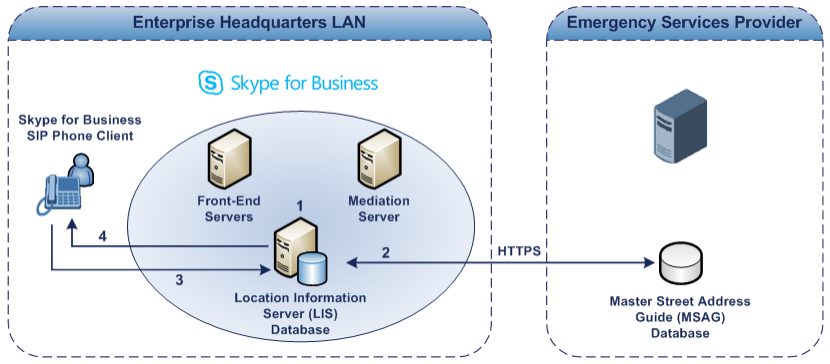Gathering Location Information of Skype for Business Clients for 911 Calls
When a Microsoft Skype for Business client is enabled for E9-1-1, the location data that is stored on the client is sent during an emergency call. This stored location information is acquired automatically from the Microsoft Location Information Server (LIS). The LIS stores the location of each network element in the enterprise. Immediately after the Skype for Business client registration process or when the operating system detects a network connection change, each Skype for Business client submits a request to the LIS for a location. If the LIS is able to resolve a location address for the client request, it returns the address in a location response. Each client then caches this information. When the Skype for Business client dials 9-1-1, this location information is then included as part of the emergency call and used by the emergency service provider to route the call to the correct PSAP.
The gathering of location information in the Skype for Business network is illustrated in the figure below:

|
1.
|
The Administrator provisions the LIS database with the location of each network element in the Enterprise. The location is a civic address, which can include contextual in-building and company information. In other words, it associates a specific network entity (for example, a WAP) with a physical location in the Enterprise (for example, Floor 2, Wing A, and the Enterprise's street address). For more information on populating the LIS database, see Adding ELINs to the Location Information Server. |
|
2.
|
The Administrator validates addresses with the emergency service provider's MSAG –a companion database to the ALI database. This ensures that the civic address is valid as an official address (e.g., correct address spelling). |
|
3.
|
The Skype for Business client initiates a location request to the LIS under the following circumstances: |
|
●
|
Immediately after startup and registering the user with Skype for Business |
|
●
|
Approximately every four hours after initial registration |
|
●
|
Whenever a network connection change is detected (such as roaming to a new WAP) |
The Skype for Business client includes in its location request the following known network connectivity information:
|
◆
|
Media Access Control (MAC) address |
|
●
|
Depends on network connectivity: |
|
◆
|
Wireless access point (WAP) Basic Service Set Identifier (BSSID) |
|
◆
|
Link Layer Discovery Protocol-Media Endpoint Discovery (LLDP-MED) chassis ID and port ID |
For a Skype for Business client that moves inside the corporate network such as a soft phone on a laptop that connects wirelessly to the corporate network, Skype for Business can determine which subnet the phone belongs to or which WAP / SSID is currently serving the soft-client.
|
4.
|
The LIS queries the published locations for a location and if a match is found, returns the location information to the client. The matching order is as follows: |
This logic ensures that for any client that is connected by a wireless connection, a match is first attempted based on the hardware address of its connected access point. The logic is for the match to be based on the most detailed location. The subnet generally provides the least detail. If no match is found in the LIS for WAP BSSID, LLDP switch / port, LLDP switch, or subnet, the LIS proxies the MAC address to an integrated Simple Network Management Protocol (SNMP) scanning application. Using SNMP may benefit some organizations for the following reasons:
|
●
|
LLDP is not supported by Skype for Business so this provides a mechanism for soft phones to acquire detailed location information. |
|
●
|
Installed Layer-2 switches may not support LLDP. |
If there is no match and the LIS cannot determine the location, the user may be prompted to manually enter the location. For example, the client may be located in an undefined subnet, at home, in a coffee shop or anywhere else outside the network. When a user manually provides a location, the location is mapped based on the MAC address of the default gateway of the client’s network and stored on the client. When the client returns to any previously stored location, the client is automatically set to that location. A user can also manually select any location stored in the local users table and manage existing entries.
